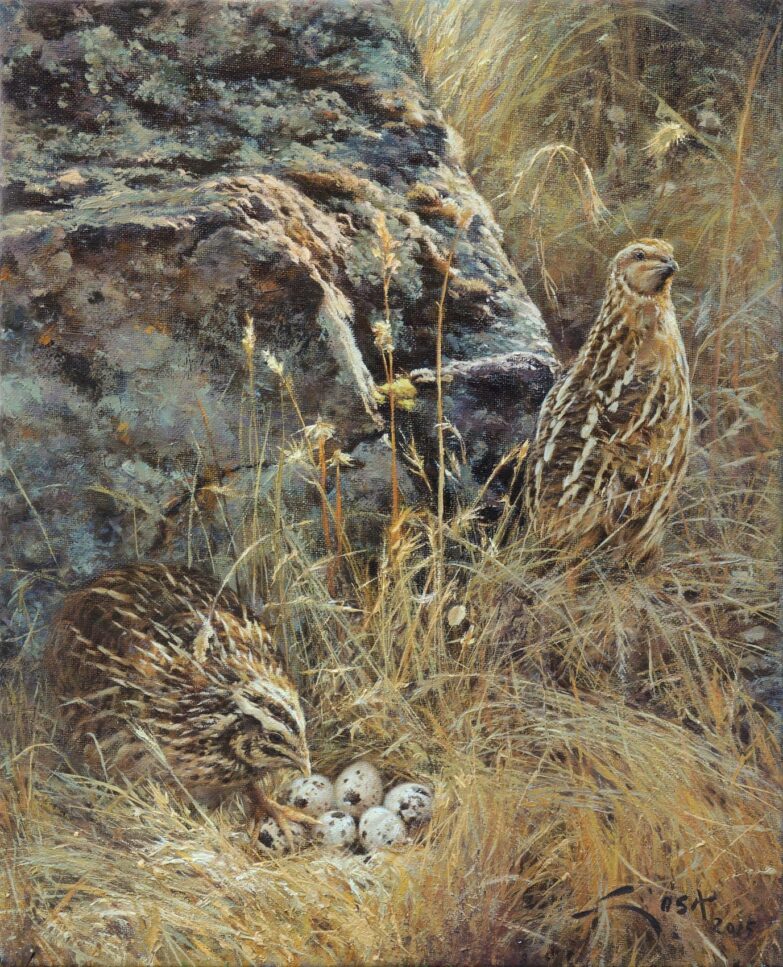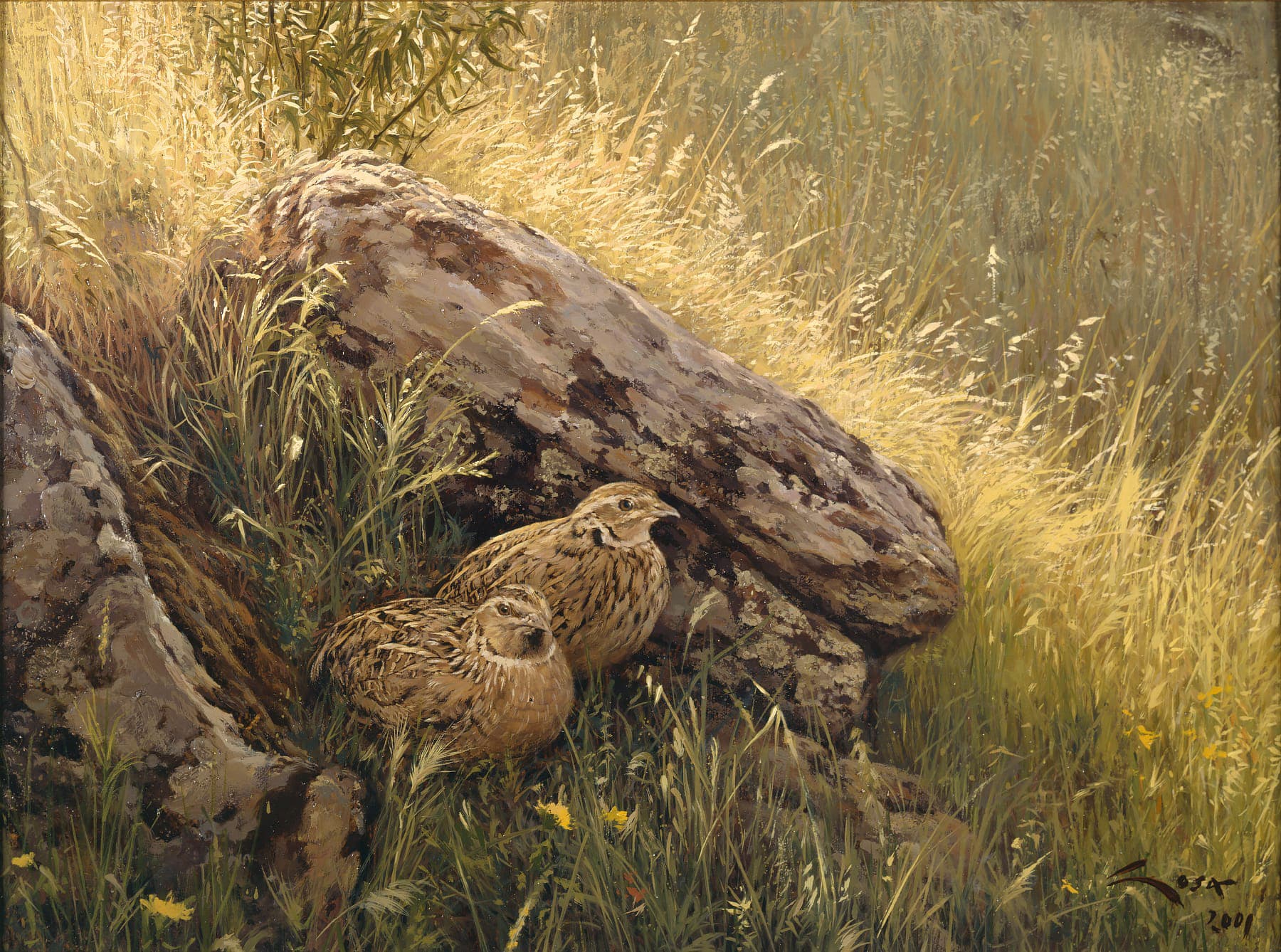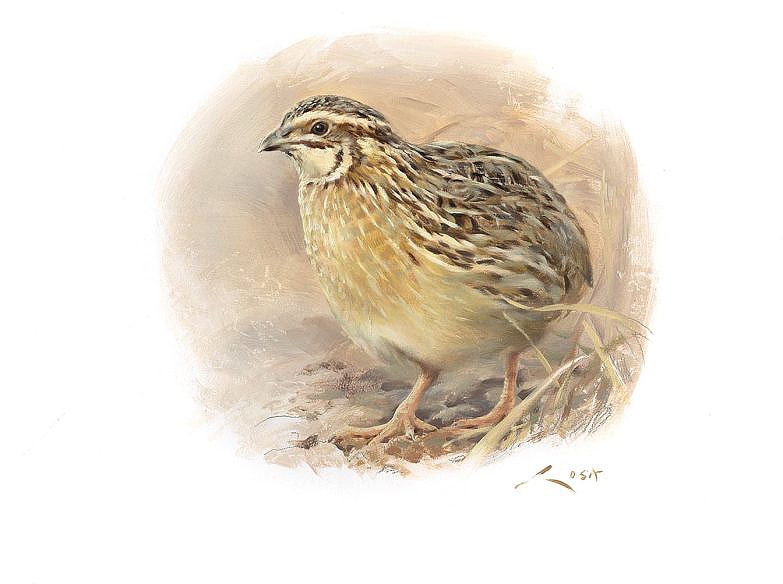The Quail
Article on quail, illustrated with pictures of quails by the painter Manuel Sosa.
CWhen, in mid-May, the rhythmic and penetrating song of the quail (Coturnix coturnix) begins to be heard from the distance of a wheat field, it is rare for anyone familiar with the countryside not to stop and enjoy its sound for a while. This is because, after all, this is as characteristic a sign of spring as the blossoming of trees or the germination of crops. Its song, a cadenced uit-uit-uit, has made it a popular animal. This is reflected in the names given to the quail by country people in many parts of Europe. The English wet-my-feet or wet-my-lips, the French paye-tes-dettes or pos-po-lin yasco are no more than onomatopoeic names for the smallest of our fasianids. The quail has a very wide distribution area. It occupies the whole of Eurasia without exceeding 63 degrees North latitude, and also extends to Barbary, Lower Egypt and South Africa - from Kenya to Angola and the Cape, as well as Madagascar. Like all widely distributed species, the quail is differentiated into a number of subspecies, including the famous Japanese quail, which is industrially exploited on farms. Many pictures of quails have been painted in the history of painting. Here are two paintings by the painter Manuel Sosa which perfectly illustrate the quail.
The quail is about 18 cm long and looks like a small partridge. The sandy-coloured dorsal part is longitudinally furrowed with a series of brown and black stripes. The sides also have light and dark stripes that contrast with the pale tones of the underparts. The male has a reddish chest and black patches on the neck, while the female, more muted in colour than the male, differs from the male in having a dark brown barred chest and a uniform brown neck. There is, therefore, a certain degree of sexual dimorphism. In any case, although their sonorous song can be heard from a considerable distance, quail are rarely seen, except when they are lifted by hunting dogs in the summer, forcing them to fly low for a short distance. The quail could be considered as the "travelling relative" of the gallinaceous birds, because it has been the only species that, in the midst of a group of mainly sedentary birds, or at most somewhat transhumant, has developed a wide-ranging migratory behaviour. However, it is important not to generalise on this point, as it has been shown that the migratory instinct affects different subspecies in different ways. Thus, quail populations on the islands of Cape Verde, the Azores, the Canaries and Madeira have been found to have different migratory instincts depending on the subspecies concerned. Azores, Canary Islands and Madeira have a totally sedentary behaviour. In the picture, quail in the incubation period.
The same can happen with North African quails which, when faced with adverse conditions, flee northwards to countries such as Italy. Many of these quails often display the incubator plate - a plucked area of the belly used to warm the eggs during incubation - which suggests that they have previously reproduced or at least attempted to do so. In many cases, these birds lay a second clutch, which contradicts the usual single brood characteristic of this species. The long migratory journey that each year moves tens of thousands of quails between their breeding areas and their winter quarters is full of dangers. Adverse weather conditions, exhaustion, predators and accidents are factors that claim thousands of lives of a species that is nevertheless capable, under natural conditions, of withstanding such a significant reduction in numbers. But this small bird, like so many others, has also been unable to escape the greedy gaze of man. The quality of its meat and the possibilities of massive captures offered by its migratory flocks have been the reason for hunting it since ancient times. Various devices, from nets and traps to rifles and hawks, were used to capture hundreds of thousands of quails every year along the coast of North Africa, Egypt, Italy, Greece and Turkey. These practices, initially carried out on a small scale, gradually increased. They soon became not only a source of food for the men who practised them, but also a lucrative business. Thus, rents were established according to the yield and catches of certain coastal stretches - they were caught when they arrived exhausted after their journey from the sea - and modern transport, preservation and marketing techniques were introduced. Thus, by 1885, Egypt was exporting around 300,000 canned quails per year, exceeding half a million in certain years - in 1920, three million quails were exported. The same can be said of Malta, with 25,000 quails a year in the 1940s, or Capri, which exported 150,000 in 1850. Naturally, such abusive hunting had to be left to be felt.
The quail's abundance and distribution was reduced. In the 1920s, the alarming decline of the European quail set in motion a series of pressure groups, made up of wildlife conservationists and hunters, who after long protests succeeded around 1938 in getting the International Hunting Council to reach an agreement to put an end to the importation of quail. In addition, the exporting countries were asked to ban this massive hunting - which in many cases continued throughout the spring - throughout the year. This led to a decrease in the quail trade from that time onwards. But the odyssey of the quail's journey does not end until it crosses the Sahara. And this immense desert, dry and stark, will be the final test it will have to undergo before reaching its wintering grounds. Demographic data As we have seen, migration is a continuous wear and tear for the quail populations that practice it. But if this natural attrition is increased by the aforementioned abusive hunting and the alteration of breeding areas, the regression to which this species has been subjected is not surprising. During the last hundred years the European quail population suffered an alarming decline. A number of new factors such as the transformation of former quail-friendly countryside by modern agricultural techniques, insecticides and the proliferation of sport hunters have contributed to further burdening the quail's loss-making "balance of payments". In countries with a long ornithological tradition, such as the British Isles, quail numbers have been closely monitored. Thus, a marked decline has been observed since 1870, and the species virtually disappeared in Ireland in 1920. Sporadically and in good years, it partially recovered - a phenomenon that can be extended to the rest of Europe. In 1964 it was extraordinarily abundant. Similar data seem to be obtained from the rest of the countries frequented by this species. When comparing reports of old hunts or isolated data from ornithologists and amateurs from the last century with the results of current hunts and observations, a huge decrease in numbers can be seen. Given the hunting interest of the species, numerous hunting organisations have tried to reintroduce it in different countries. In France, Italy and Luxembourg, hundreds of quails imported from other countries (mainly Egypt) or captured during migration have been released. These restockings have had little success in terms of depredation ' as the quails have tended to scatter. The attempt to fix in one place such eclectic, dispersive and migratory birds as the quail must logically have been doomed to failure. And this is the uncertain outlook for the European quail. Let us hope that civic-mindedness and good logic know how to make intelligent use of the possibilities that this animal species, like so many others, offers mankind. But in order to do so, we must not forget that nature has its rules of the game and that these rules, in the interest of all, must be respected.
Some populations of the southern end of the African subspecies, which extends across southern Africa, are somewhat more migratory. Finally, the quail living in our Eurasian countryside - coturnix coturnix coturnix coturnix subspecies - to which we are mainly going to refer, shows a gradation in its migratory behaviour, as a progressive decrease can be observed from north to south.
Thus, quails inhabiting more northern and continental areas are forced to make long migrations away from the harsh winter conditions of these latitudes, while their more southerly relatives are not so harassed by the rigours of the climate. It is for this reason that in the regions on the southern edge of their breeding range - the Mediterranean basin - groups of native quail will overwinter with quail from Central Europe, the British Isles or the Russian plains. In many cases, wintering has been favoured by recent ecological modifications, due to human action which, as in the case of the southwest of the Iberian Peninsula, has increased the protection and food available with the establishment of large irrigated areas. In any case, this cir wintering is only carried out by small numbers of quails, the vast majority of which undergo a gruelling journey across the Sabara to reach the tropical savannahs that surround the southern edge of this desert. Movements, as far as Europe in general is concerned, will begin in late July, although the bulk of the European population will be on the move by the end of August or early September. However, stragglers may be found in September and even in November. During this period quail will be flying in the dark of night, as, like many other migratory birds, they move mainly between sunset and sunrise. It has been observed that the migratory routes of this species avoid crossing wide arms of the sea and, therefore, cross the Mediterranean, taking advantage of the natural bridges of the Iberian and Italic peninsulas and the Balkans, or skirt the sea via the Near East. In this way, the populations of the Atlantic region, Central and Eastern Europe and the vast steppes of Russia and Western Asia are drained. It has been postulated that quail have a type of migration known as "loop migration". This name is given to the phenomenon whereby a migratory species makes its autumn journey using an itinerary that does not coincide with the return journey in spring. This type of migration seems to occur irregularly in certain quail populations in Switzerland, northern Italy and nearby regions of central Europe. These birds will travel to Africa in autumn via France and the Iberian Peninsula and return in spring via Tunisia and Italy. The first arrivals of quail on the Iberian Peninsula begin to be seen as early as March, with a peak in April. They soon occupy a wide range of open land, pastures, sunny cereal fields, and irrigated meadows or mountain meadows. The song of the male, which lasts until August, is one of the few indications that this species, which lives a hidden and nocturnal life, gives us of its presence. Once the pair is formed, the male takes a less active part in building the nest and raising the offspring. The female, therefore, is in charge of building the nest, which is no more than a hole dug in the ground and hidden in the grass. It is limited by a series of blades of grass that the quail deposits around it. The laying season varies according to the latitudes, being carried out on average between May and June. It lays 7 to 12 yellowish eggs, spotted with dark brown, although in exceptional cases up to 18 have been counted. They measure 28 to 33 mm long by 21.5 to 24.5 mm wide and weigh 8 to 9 g. After 16 to 21 days of incubation, the quail chicks hatch and, as genuine representatives of the nestling type, are covered with down and ready to scurry about in search of food. They have a reddish head, with a stripe in the centre bordered with black and two spots above the ear, one of which is yellowish. The back has a reddish-yellowish plumage with two black stripes. The wings also have spots of the same colour. Underneath they are yellowish. The chicks grow very fast, fluttering at 11 days, and are able to fly perfectly at 19 days. The young resemble the adult female, but with a less marked breast. A strong dispersal tendency has been observed in young birds in certain regions. Many of them, before embarking on the actual migration, spread out irregularly over more or less distant regions. For example, young people born in North Africa have been trapped in Italy and Spain. Early movements are also reported among young people from Italy, Switzerland, France and Hungary. But quails also exhibit a certain irruptive character. When ecological conditions change abruptly during the breeding period, whole populations of quail may move en masse to more favourable breeding sites. This is the case, for example, with quail in the Russian steppes which, in years of prolonged drought, flee northwards and to other regions of Russia where they are found in large numbers.



